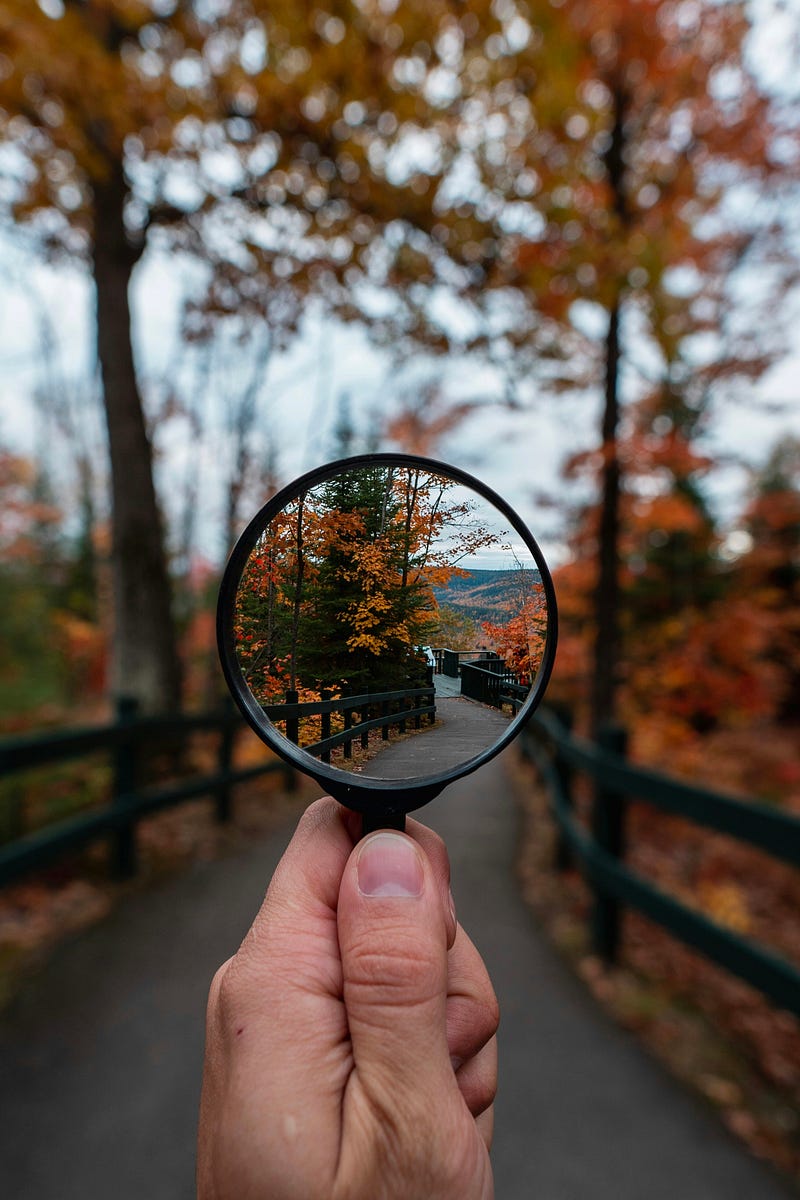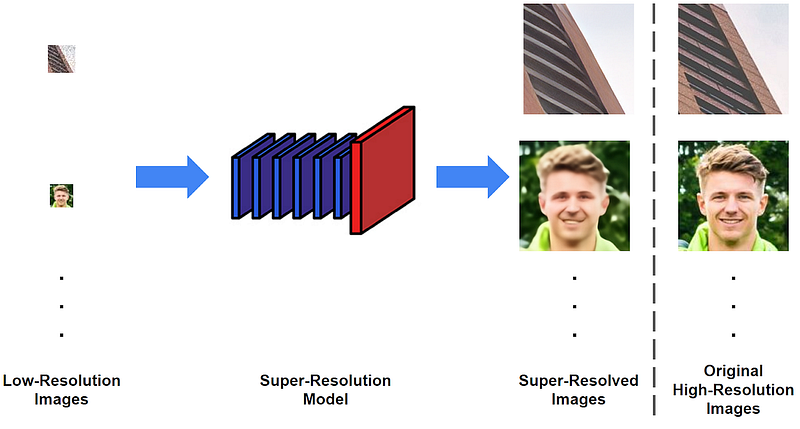Super Resolution(SR) Process
Super Resolution(SR) Process
Easy:
Imagine you have a small, blurry picture of your favorite cartoon character. You want to make it bigger and clearer so you can see all the details. Super Resolution is like a magical tool that helps make small, blurry pictures look bigger and sharper, like when you use a magnifying glass but even better!
Here’s how it works:
- Small Picture: You start with a small, fuzzy picture. It’s like a drawing with not many details.
- Magic Tool (Super Resolution): Think of this tool as a super-smart artist. It looks at the small picture and guesses what it should look like if it were bigger and clearer.
- Learning from Examples: The tool has learned from many other pictures. It’s like how you get better at drawing by looking at lots of other drawings. The tool knows what a clear picture of a cartoon should look like.
- Adding Details: Using what it has learned, the tool adds details and sharpness to the picture. It fills in the missing parts, so the picture looks more like what you’d expect a clear, big picture to be.
- Big and Clear Picture: Now, the picture is bigger and much clearer! You can see all the details, like the character’s eyes, smile, and even tiny patterns on their clothes.
So, Super Resolution is like having a super-smart artist who can take a tiny, blurry picture and turn it into a big, clear masterpiece!

Moderate:
Super Resolution (SR) is a technique in image processing that enhances the resolution of an image, making it clearer and more detailed. It typically involves using algorithms and machine learning models to upscale low-resolution images. Here’s a more detailed explanation of the process:
- Input Image
You start with a low-resolution (LR) image. This image is smaller in size and has fewer details. - Interpolation (Traditional Approach)
Before advanced techniques, simpler methods like interpolation were used. Methods such as bilinear or bicubic interpolation estimate new pixel values to create a larger image. However, these methods often result in blurry images with less detail. - Deep Learning Models
Modern Super Resolution often uses deep learning, particularly Convolutional Neural Networks (CNNs). These models are trained on large datasets of images, learning to predict what a high-resolution (HR) version of a low-resolution image should look like. - Training the Model
Data Preparation: The model is trained using pairs of low-resolution and high-resolution images. The low-resolution images are created by downscaling the high-resolution ones.
Learning Features: The model learns to recognize patterns, textures, and details in images. It understands the relationship between low-resolution and high-resolution versions.
Loss Function: During training, a loss function measures the difference between the model’s output and the actual high-resolution images. The model adjusts its parameters to minimize this loss, improving its accuracy. - Generating High-Resolution Images
Once trained, the model can take a new low-resolution image and generate a high-resolution version. Here’s how it does that:
Feature Extraction: The model analyzes the low-resolution image to extract important features.
Upscaling: The model uses these features to upscale the image, adding predicted details and enhancing clarity.
Post-Processing: Additional processing may be applied to fine-tune the image, ensuring it looks natural and sharp. - Output Image
The result is a high-resolution image that appears much clearer and more detailed than the original low-resolution input. The success of this process depends on the quality of the training data and the effectiveness of the model.
Key Techniques in Super Resolution
- Single Image Super Resolution (SISR): Enhances one image at a time.
- Multiple Image Super Resolution: Combines information from several images to improve resolution.
- Generative Adversarial Networks (GANs): A more advanced approach where two neural networks (a generator and a discriminator) work together to produce highly realistic high-resolution images.
Applications
- Medical Imaging: Improving the clarity of medical scans.
- Satellite Imagery: Enhancing details in satellite photos.
- Security and Surveillance: Clarifying footage for better analysis.
- Entertainment: Upscaling movies and video games for higher resolution displays.
Super Resolution leverages advanced algorithms and machine learning to transform low-quality images into detailed, high-quality versions, greatly expanding the potential for various practical applications.

Hard:
Super resolution is a process that enhances the resolution of an image or video by combining multiple low-resolution (LR) images to form a single high-resolution (HR) image. This process involves several steps:
Overview of the Super Resolution Process
- Data Collection: Multiple low-resolution images of the same scene are collected. These images can be taken from different angles, under different lighting conditions, or at different times to capture more details.
- Preprocessing: Each low-resolution image is preprocessed to remove noise and enhance the quality. This can include techniques like demosaicing, which reconstructs the missing color information in digital photographs.
- Alignment: The low-resolution images are aligned to ensure that they are properly registered. This step is crucial for preserving the motion consistency in video super-resolution.
- Feature Extraction: Features are extracted from each low-resolution image. These features can include edges, lines, and textures.
- Propagating Features: The features are propagated through the images to capture the temporal information in video sequences. This step helps to improve the upscaling quality.
- Aggregation: The aligned and propagated features are aggregated to form a single high-resolution image.
- Upsampling: The aggregated features are then upsampled to the desired resolution using techniques like bicubic interpolation or deep learning-based methods.
- Postprocessing: The final high-resolution image is postprocessed to refine the details and remove any remaining noise.
Deep Learning Techniques
Deep learning has significantly improved the super resolution process by automatically extracting features and learning complex mappings between low-resolution and high-resolution images. Techniques like convolutional neural networks (CNNs) and generative adversarial networks (GANs) have been particularly effective in enhancing the resolution of images and videos.
Evaluation Metrics
The quality of the super-resolved images is typically evaluated using metrics such as:
- Peak Signal-to-Noise Ratio (PSNR): This measures the ratio between the maximum possible power of a signal and the power of the corrupting noise.
- Structural Similarity Index Measure (SSIM): This measures the similarity between the super-resolved image and the original high-resolution image, taking into account factors like correlation, luminance distortion, and contrast distortion.
Applications
Super resolution has numerous applications in various fields, including:
- Surveillance: Enhancing the resolution of security camera images for facial recognition and object detection.
- Medical Imaging: Improving the resolution of MRI images to capture more detailed information.
- Media: Reducing server costs by sending media at lower resolutions and upsampling on the fly.
- Astronomy: Enhancing the resolution of images of celestial bodies to capture more detailed information.
Conclusion
Super resolution is a powerful technique for enhancing the resolution of images and videos. By combining multiple low-resolution images and using advanced deep learning techniques, it is possible to create high-resolution images that are indistinguishable from the original high-resolution images.

Comments
Post a Comment